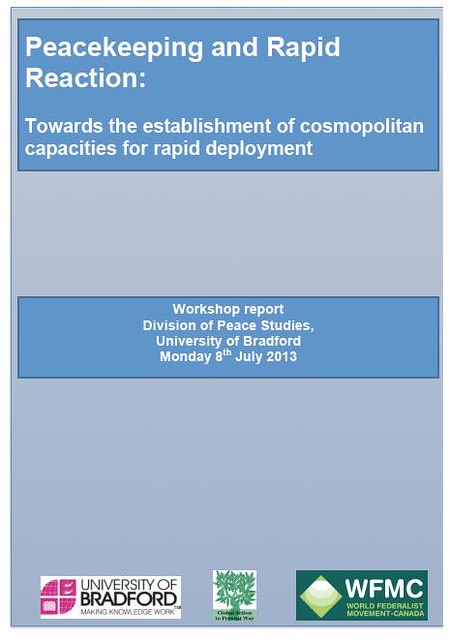GP Responses: Shouldn’t UNEPS Advocacy be Front and Centre?
Robin Collins argues that a recent workshop on rapid reaction missed an opportunity to embrace and advance the proposal for a U.N. Emergency Peace Service. For the workshop's report please click here.
The workshop “Peacekeeping and Rapid Reaction: Towards the establishment of cosmopolitan capacities for rapid deployment”[1] had its eye on salient peace operations options. This was good timing. Responsibility to Protect doctrine and controversy is in the limelight, and many highly volatile zones of conflict call out for an appropriate, yet urgent, response. By the end of the report, however, you come to appreciate that some of the participants are not enthusiastic about one central project at the heart of the debate: the U.N. Emergency Peace Service (UNEPS).[2]
The urgency of a rapid reaction capability at the U.N. was catapulted into the peace operations discourse back in 1992 when Boutros Boutros-Ghali’s An Agenda for Peace arrived and then, again, by the genocide in Rwanda when peacekeepers were caught ill-equipped, trained for other tasks, and without authority to act.
The U.N. Secretary-General wrote [3] that the world needed a new type of “peace-enforcement units in clearly defined circumstances and with their terms of reference specified in advance.” These volunteers “would have to be more heavily armed than peace-keeping forces and would need to undergo extensive preparatory training within their national forces. […They] should not be confused with the forces that may eventually be constituted under Article 43 to deal with acts of aggression or with the military personnel which Governments may agree to keep on stand-by for possible contribution to peace-keeping operations.”[4]
Something between peacekeeping (standing between protagonists but at their consent) and war-fighting (to push back aggression of one state against another.) A significant problem with the Bradford report, in my opinion, is a failure by several contributors to sufficiently distinguish rapid reaction capability from peacekeeping, something that the former Secretary-General was explicit about.[5] The Bradford workshop was ostensibly to be about rapid reaction and peacekeeping; but in the very few papers presented, it ended up favouring “rapid reaction peacekeeping”, which is a more contentious hybrid.
In “‘Cosmopolitan-minded’ Militaries: Beyond the National Military but before UNEPS?” Jonathan Gilmore acknowledges the “productive contribution” of UNEPS to the “longer-term debate on a standing U.N. force.” But it’s an idea he finds “beset by some considerable limitations.”
UNEPS advocates acknowledge the current lack of political will in favour of their ambitious project, and Gilmore thinks one very big problem lies in “unclear” and “fairly arbitrary” budgeting (~$2.5 billion start-up and $1 billion annually). By arbitrary Gilmore seems to mean too cheap.[6] Peter Langille, the primary author of the contemporary UNEPS proposal,[7] has been cautious but adamant about prospects for “peace enforcement units” at the U.N. in light of the economic climate. In a recent outline, we are reminded of the limitations of a (short-sighted) austerity mindscape, the ongoing obsession with “doing more with less.”[8] Boutros Boutros-Ghali, when responding to complaints about a $3 billion annual peacekeeping budget, called the cost “farcical” when contrasted against the costs of the alternative: war.
But the UNEPS financial estimates don’t come out of the blue. Even if we set aside our temptation to argue that UNEPS is a sweet deal at any price, we can find the number crunching. Gilmore references a shorter piece, written in 2012, but not the 2006 “UNEPS blue book”[9] nor the 2002 foundational review by Langille[10] that structured it. The budget predictions are extrapolations from earlier studies[11] and current U.N. compensaton rates. “Remuneration [of UNEPS employees], as well as comprehensive insurance and pension programs,” wrote Langille, “would be based on a scale similar to that of personnel within the U.N. Secretariat, which provides compensation for expertise, special skills and experience.”
Both a full and scaled-down estimate have been offered, and a note emphasizes, in the manner of Boutros-Ghali’s 1992 phrasing, that UNEPS annual costs would be the equivalent of buying one B-2 bomber each year. If political will is the central issue -- and it is -- that roadblock is not being held up by the costing formula.[12] 
Could it be, then, that the Security Council must be reformed first? asks Gilmore. Most would agree that the current state of P5 dominance is a serious governance issue, but UNEPS advocates could go farther by suggesting that UNEPS is part of the reform package. The two concepts -- reform and rapid response -- work in tandem. Ironically, Gilmore references the International Criminal Court as evidence for the limits of influence of new international norms. To the contrary, the point is: We can lead the charge for new capacity ideas, or follow along behind with the all-too-familiar Security Council spoilers who cynically believe that things will never change.
Those are the “obvious problems”, writes Gilmore. The “more pervasive problems are “short-termism,” a “lack of focus” on what roles UNEPS will perform, and whether UNEPS will be able to deter mass atrocities. Is there merit in these critiques?
• It is self-evident that the United Nations does not and cannot respond quickly enough to certain kinds of threats. We need specific designs for each subset of problems. To simplify, let’s focus on Rwanda genocide-like problems,[13] wherein an early response of robust, multi-purposed neutral (U.N.) armed, police and civilian services at the request of the U.N. Secretary-General will begin to aid civilians at high risk within one or two days, not months. That capacity would never be able to wage large scale warfare. It could stop an escalating problem from getting out of control until national or regional resources or U.N. peacekeepers are brought in. That’s not a problem or limitation of UNEPS – rather, that facility is the core idea.
• Is six months maximum duty too little or too much; is a 15-18,000 force too small or too large? These kinds of complaints, highlighted by Gilmore when challenging UNEPS’ deterrent ability, are offered up as if those parameters are problematic, or haven’t been considered. A transition to other forces, if necessary, would be planned from the beginning. But unlike peacekeepers and national forces, UNEPS recruits would be permanent employees hired by the U.N., trained in a wide range of specialized tasks, including conflict-resolution, diplomacy, as well as in policing and military skills. They would complement existing capacities. Once the bottle is corked, UNEPS can be gone. There would be as early a hand-off as is feasible.
• There is much room for debate over how long a rapid reaction force needs to be deployed. But is the core UNEPS proposal not ambitious enough? Brian Urquhart called for a 5,000 troop U.N. force in 1993, and Romeo Dallaire said that with a similar number he could have prevented the Rwanda genocide.[14] Politically-speaking, a 100,000 strong U.N. standing army will be intimidating to some smaller states, and too much of a good thing for those who perceive themselves already as the de facto world police.[15] That’s confirmation of why an early-in, early-out, small scale force is interesting and more saleable, and hardly “deeply problematic”, as Gilmore asserts. Langille proposed that the limited duration of deployments would still require “replacements or rotations within three to six months, with augmentation and reinforcement in the event of a serious escalation.”[16] The big benefit, though, is that a “911” peace service doesn’t have to be recruited. It’s ready to go.
• You can’t seriously argue that UNEPS is too small, and too quick to withdraw, unless you have a big cheap alternative in mind that works better. Gilmore shows a preference for “cosmopolitanism-minded national militaries”, which appears more like a competing, rather than a complementary, proposal. The “UN-employed and recruited” attribute of UNEPS is essential to the early prioritising of independent, neutral, right authority over narrow strategic interests -- something that national militaries can rarely achieve. Gilmore is right, however, in thinking the UNEPS skill sets and training regimes should be considered for national militaries and peacekeepers too. UNEPS may lead the way. It may also make large national militaries obsolete. Is that a problem for us?
David Curran’s contribution “Why Discuss Rapid Reaction?” also appears to offer poison pills for several key UNEPS principles (without dismissing UNEPS directly). He calls for rapid reaction peacekeeping or upgraded peacekeeping, instead of a uniquely new capacity. He says we need to “unpack the role of force to protect civilians”, which may or may not indicate a preference for more robust or -- conversely -- a gentler peacekeeping. But for Rwanda, 1994?
Curran highlights rapid reaction efforts current at the regional level (European Union and African Union), rather than what is proposed at the UN-level. And he claims that standby (not standing) forces can be “deployed immediately.” If UNEPS is strident about anything, it is that standing forces are inherently more rapid. The evidence is that standby forces (SHIRBRIG, PK) are not. But Curran maybe lets the cat out of the bag when he writes in favour of rapid reaction peacekeeping "as a logical progression” (from traditional peacekeeping), “as opposed to a jump into the unknown" (by which he means UNEPS.) Gareth Evans, in his book on Responsibility to Protect, agreed that a standby arrangement “can never be as efficient as an immediately available standing force.”[17] The throughput demands of bodies and expertise, with equipment, basing and infrastructure, together determine the expense, the scale and the tenure. The likelihood of success has yet to be tested.
Curran is right that in our obsession with getting in and out fast, we risk restoring a conflict zone to its previous, precarious, state -- “a relapse into conflict”. But I’m not sure that concern counts as a critique of UNEPS either. Could it be related to an incomplete or faulty implementation of Responsibility to Protect and the ignoring of its “continuum of obligations”, (which includes the responsibility to prevent and to rebuild), [18] or is it just bad decision-making at the U.N. Security Council? In other words, another political will issue? As proposed, a UNEPS would include immediate peacebuilding and quick impact projects to ensure ongoing efforts are well-sequenced from the start and then continued through any critical transitions.
Robert Zuber concludes with some familiar proposals, and he usefully suggests bringing together past U.N. Resolutions that have condoned protection and early responses. (The R2P campaigners may have done some of the groundwork on this.)
He also sees the need to extend the rapid reaction, peacekeeping and UNEPS outreach network. But hosted where and by whom? These are not unimportant decisions, and we need a frank, open discussion about it. The project must be inclusive, welcoming to a broad range and geography of partners and thinkers, and equipped with a forward-looking agreeable agenda. Tasks need to be delegated to those motivated to get these ideas moving through civil society and ideally toward the creation of global UNEPS centres (that would complement outreach and advocacy centres enjoyed by the International Criminal Court and Responsibility to Protect campaigns.)
Robert Zuber does call for an expansion of education and advocacy tools, an updating and expanding of the literature, and placement of UNEPS “in the larger cosmopolitan security framework.” My ears prick up at this point because I think what we need into the future, and embraced by any institutional host, are experts with a strong appreciation for the categories and roles that fit together, on one hand, and that are differentiated, on the other. A new generation of activists and academics is also welcome, as Zuber notes in his summary of “next steps”, but the salient ideas found in the existing literature are waiting primarily for solutions to that riddle called political will.
Developing a UNEPS into reality will require deep cooperation among individuals committed to core concepts(19) brought together through the last two decades -- and some serious advocacy funding.
Robin Collins is with the World Federalist Movement - Canada and has been active in a range of disarmament and global governance campaigns. These views, however, are his own.
End Notes and References:
1 The workshop was organized at University of Bradford by its Department of Peace Studies in July 2013, and was co-sponsored by University of Bradford, Global Action to Prevent War and World Federalist Movement - Canada.
2 The central work on UNEPS must include Peter Langille’s publications, such as: Bridging the Commitment-Capacity Gap: A Review of Existing Arrangements and Options for Enhancing U.N. Rapid Deployment (Wayne, N.J.: Center for U.N. Reform Education, August 2002); “Preventing Genocide and Crimes Against Humanity: One innovation and new global initiative”, Amanda Grzyb, (ed.) Darfur and the World, (Montreal: McGill-Queens University Press, 2009); “A U.N. Standing Emergency Capability: A Policy Option Paper Prepared for the Canadian Centre for Foreign Policy Development”, Global Human Security Ideas and Initiatives (c) 2000. As well: Robert C. Johansen, (ed.), A United Nations Emergency Peace Service: To Prevent Genocide and Crimes Against Humanity, (New York: Institute for Global Policy, 2006); Carl Kaysen and George Rathjens, “The Case for a Volunteer U.N. Military Force”, Daedalus (Winter, 2003), pp. 91-103; Brian Urquhart, "For a U.N. volunteer military force," The New York Review of Books, New York, June 10, 1993; “A U.N. Rapid Deployment Brigade: A Preliminary Study” (known as “The Dutch Non-paper”) The Hague: Government of the Netherlands, 1995; “Towards a Rapid Reaction Capability for the United Nations”, Ottawa: Government of Canada, 1995.
3 http://www.unrol.org/files/A_47_277.pdf
4 Boutros Boutros-Ghali, Agenda for Peace, item 44.
5 Boutros-Ghali at the time showed a preference for stand-by forces rather than a U.N. standing rapid reaction service.
6 Gilmore offers up as comparison the defence budget of the Czech Republic (a force of 18,000 cost over $3 billion in 2009.)
7 Peter Langille and Robin Collins (author of the present commentary) are both members of Council of the World Federalist Movement - Canada and in its UNEPS Working Group.
8 Langille also wrote about the experience of Libya and its effect on the popularity of R2P, and what that might have meant for successful advocacy of a U.N. standing rapid response capability. See H. Peter Langille, “Preparing for a U.N. Emergency Peace Service”, FES Perspective Paper, Friedrich Ebert Stiftung, New York, August 2012. Available: http://library.fes.de/pdf-files/iez/09282.pdf
9 Langille prepared the first draft of the proposal and developed the initial concept and model for: Robert C. Johansen, (ed.), A United Nations Emergency Peace Service: To Prevent Genocide and Crimes Against Humanity, (New York: Institute for Global Policy, 2006).
10 Peter Langille, Bridging the Commitment-Capacity Gap, Centre for U.N. Reform Education, New Jersey, August 2002: pg 107.
11 Conetta and Knight, “Design for a 15,000 person U.N. Legion”, Briefing Report 8, Project on Defence Alternatives, Commonwealth Institute, Cambridge USA, 1995; “The Report of the Independent Working Group on the Future of the United Nations, The U.N. in its Second Half Century, New York: The Ford Foundation, 1995; Dutch study of a permanent 5,000-man U.N. Brigade “A U.N. Rapid Deployment Brigade”, but also Jean Krasno, “A United Nation’s Rapid Deployment Permanent Force: Cost Analysis”, for Yale University U.N. Study Program, 1994.
12 Gareth Evans, in Responsibility to Protect: Ending Mass Atrocity Crimes Once and For All, Brookings Institution Press, Washington, 2008 page 230, compares the cost of establishing a “credible worldwide system of preventive diplomacy centres[...]which might conceivably have averted Iraq’s invasion of Kuwait” ($21 million) versus the cost of the first Iraq war ($70 billion.)
13 The four primary roles conceived of for UNEPS are: 1. prevention of armed conflict and genocide; 2. protection of civilians at extreme risk; 3. prompt start-up of demanding peace operations; 4. addressing human needs where others cannot or will not.
14 Brian Urquhart, “For a U.N. Volunteer Military Force,” NY Review of Books 40, no. 11 (1993). Gareth Evans refers to Dallaire’s view, supported by several military professionals that a force of 5,000 “could have stopped the Rwandan genocide in its tracks.” (See Gareth Evans: Responsibility to Protect: Ending Mass Atrocity Crimes Once and For All, Brookings Institution Press, Washington, 2008: page 215.
15 Gilmore notes that the March 2007 workshop at Rutgers discussed small force size as politically possible but he argues it is “deeply problematic” to suggest a lot can be achieved with such a small force in a short time frame.
16 Peter Langille, Bridging the Commitment - Capability Gap, page 98. See also Carl Kaysen and George Rathjens, “The case for a volunteer U.N. military Force”, (Daedalus, Vol. 132 No. 1 Winter 2003.) in which the authors argue that a U.N. force would be “backed up by larger forces remaining under national control.”
17 Gareth Evans, The Responsibility to Protect: Ending Mass Atrocity Crimes Once and For All, Brookings Institution Press, Washington, 2008: page 217.
18 “The responsibility to rebuild focuses on the recovery, reconstruction and reconciliation of a state and aims at preventing potential recurrences of humanitarian crises.” ICRtoP, online: http://www.responsibilitytoprotect.org/index.php/about-rtop/related-themes/2417-pbc-and-rtop
19 Let’s imagine a conference called “UNEPS: Next Steps” with a speaker list drawn from all corners of the globe, but including: Alex Bellamy (Griffiths), Hilary Benn (Leeds), Malcolm Chalmers (RUSI), Michael Codner (RUSI), Chris Coleman (UN), Carl Conetta (Project on Defense Alternatives), Gareth Evans (Global Centre for R2P), Robert Johansen (Notre Dame), Rebecca Johnson (Acronym), Mary Kaldor (LSE), Charles Knight (Project on Defense Alternatives), Joachim Koops (Brussels), Peter Langille (Canada), Volker Lehmann (FES, N.Y.), Bjorn Moller (Copenhagen), Michael Pugh (Intl Peacekeeping), George Rathjens (MIT), Adam Roberts (Oxford), Gilberto Marcos Antonio Rodrigues (Sao Paulo), Paul Rogers (Bradford), Adam Smith (IPI), Hussein Soloman (Pretoria), Lutz Unterseher (Berlin), Sir Brian Urquhart (NY), Jennifer Welsh (U.N. Sec Gen’s advisor on R2P), Tom Woodhouse (Bradford).


